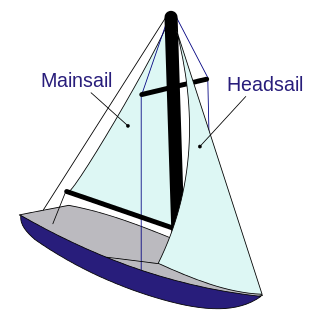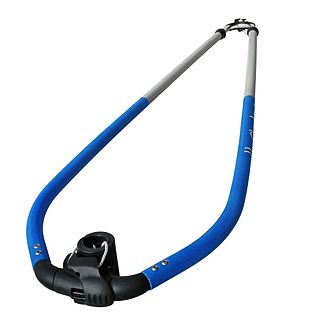
Snowboards are boards where both feet are secured to the same board, which are wider than skis, with the ability to glide on snow. Snowboards widths are between 6 and 12 inches or 15 to 30 centimeters. Snowboards are differentiated from monoskis by the stance of the user. In monoskiing, the user stands with feet inline with direction of travel, whereas in snowboarding, users stand with feet transverse to the longitude of the board. Users of such equipment may be referred to as snowboarders. Commercial snowboards generally require extra equipment such as bindings and special boots which help secure both feet of a snowboarder, who generally rides in an upright position. These types of boards are commonly used by people at ski hills or resorts for leisure, entertainment, and competitive purposes in the activity called snowboarding.
Boardsports are sports that are played with some sort of board as the primary equipment. These sports take place on a variety of terrain, from paved flat-ground and snow-covered hills to water and air. Most boardsports are considered action sports or extreme sports, and thus often appeal to youth. A large proportion of youth partaking in these sports, together with aesthetic damage to property from sports like skateboarding, has led to many board sports being marginalized by the greater world of sports in the past. However, many board sports are ever-more frequently gaining mainstream recognition, and with this recognition have enjoyed wider broadcast, sponsorship and inclusion in institutional sporting events, including the Olympic Games.

The kickflip is a maneuver in skateboarding in which a rider flips their skateboard 360° along the axis that extends from the nose to the tail of the deck. When the rider is regular footed the board spins counter-clockwise if viewed from the back.

A sailboat or sailing boat is a boat propelled partly or entirely by sails smaller than a sailing ship. Distinctions in what constitutes a sailing boat and ship vary by region and maritime culture.

Kiteboarding is an action sport combining aspects of wakeboarding, snowboarding, windsurfing, surfing, paragliding, skateboarding and sailing into one extreme sport. A kiteboarder harnesses the power of the wind with a large controllable power kite to be propelled across the water, land, or snow.

Windsurfing is a surface water sport that combines elements of surfing and sailing. It consists of a board usually 2 to 2.5 metres long, with displacements typically between 45 and 150 litres, powered by wind on a sail. The rig is connected to the board by a free-rotating universal joint and consists of a mast, boom and sail.
On “short” boards The sail area generally ranges from 1.5 to 12 square metres depending on the conditions, the skill of the sailor, the type of windsurfing being undertaken and the weight of the person windsurfing. On long boards, upon which the sport was first popularized -sail areas and board lengths are typically larger and the athleticism required is much less.

Skimboarding is a boardsport in which a skimboard is used to glide across the water's surface to meet an incoming breaking wave, and ride it back to shore. Wave-riding skimboarders perform a variety of surface and air maneuvers, at various stages of their ride, out to, and back with, the wave. Some of these are known as "wraps," "big spins," "360 shove-its" and "180s." Unlike surfing, skimboarding begins on the beach by dropping the board onto the thin wash of previous waves. Skimboarders use their momentum to skim out to breaking waves, which they then catch back into shore in a manner similar to surfing.

Longboarding is the act of riding on a longboard. A longboard varies in shape and size unlike its set counterpart, the skateboard, and has more stability, traction and durability due to larger wheel size and lower wheel durometers. Many, but not all longboards, use trucks (axles) that contain different geometric parameters than a skateboard as well. These factors and their variation have given way to a variety of disciplines, functions and purposes for a longboard. Longboarding also has competitive races down hill where some riders reach speeds exceeding 60 miles per hour. The angles at which some longboards can turn, as well as their ability to coast long distances make them more suitable for cruising and commuting on streets than regular skateboards.

A foilboard or hydrofoil board is a surfboard with a hydrofoil that extends below the board into the water. This design causes the board to leave the surface of the water at various speeds.
In fluid dynamics, drag is a force acting opposite to the relative motion of any object moving with respect to a surrounding fluid. This can exist between two fluid layers or a fluid and a solid surface. Unlike other resistive forces, such as dry friction, which are nearly independent of velocity, drag forces depend on velocity.
Drag force is proportional to the velocity for a laminar flow and the squared velocity for a turbulent flow. Even though the ultimate cause of a drag is viscous friction, the turbulent drag is independent of viscosity.

Front loop is the name given to a trick performed by a windsurfer whereby the rider performs a jump from a wave face and forces the sail, board and rider to perform a forward somersault in one motion. In its basic form, the rider's hands maintain their position on the boom and the rider's feet maintain their position on the board. Some consider the forward loop to be one of the harder intermediate moves to learn as it goes against most learned reactions whilst sailing.
A freestyle skateboarding trick is a trick done on a skateboard while freestyle skateboarding. Some of these tricks are done in a stationary position, unlike many other skateboarding tricks. The keys to a good freestyle contest run are variety, difficulty, fluidity, and creativity. It should also be noted that this is a partial list, and a full list would never be possible, because new tricks and new combinations are always being created.

In skateboarding, grinds are tricks that involve the skateboarder sliding along mainly relying on the use of the trucks of a skateboard. Grinds can be performed on any object narrow enough to fit between wheels and are often performed on the coping (edge) of a skate ramp, a purpose-built "funbox", step, ledge or horizontally-positioned pole.
A slide is a skateboarding trick where the skateboarder slides sideways either on the deck, on the trucks or on the wheels.

Kite landboarding, also known as land kiteboarding or flyboarding, is based on the sport of kitesurfing, where a rider on a surf-style board is pulled over water by a kite. Kite landboarding involves the use of a mountain board or landboard, which is essentially an oversized skateboard with large pneumatic wheels and foot-straps. Kite landboarding is a growing sport, and there are several competitions. Kite landboarding is attracting growing publicity although it is not yet as popular or as well known as kitesurfing.

The sit-down hydrofoil, first developed in the late 1980s, is a variation on water skiing, a popular water sport. When towed at speed, by a powerful boat or some other device, the board of the hydrofoil 'flies' above the water surface and generally avoids contact with it, so the ride is largely unaffected by the wake or chop of the water and is relatively smooth. The air board is a modified hydrofoil where the skier stands up.

Flowriding is a late-20th century alternative boardsport incorporating elements of surfing, bodyboarding, skateboarding, skimboarding, snowboarding and wakeboarding.














